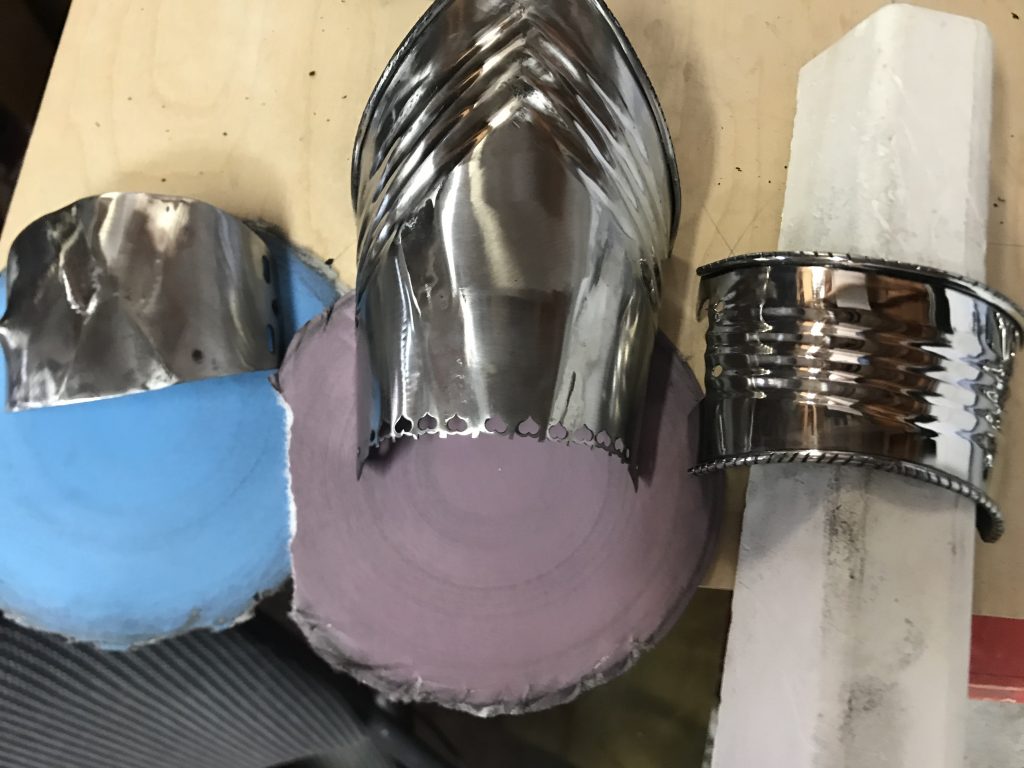Taking a bit of a side trip from the string of gauntlet specific posts to discuss the significant differences between polishing techniques between Carbon and Stainless steel – Carbon steel polishes in a similar manner to mild steel, so if you want to polish mild steel you can use this methodology – but Mild steel is a pretty horrible material for armour (other than costume armour) so I’d recommend spending the extra time and going to a carbon steel, since this will drop your weights by half AND increase the durability. It also doesn’t scratch if you look at it funny, which Mild (and to a lesser extent stainless) do.
Stainless versus Carbon steel – what’s the difference?
One of the major differences between stainless steel and other steels is actually how heat conductive it is. If you have welded these, stainless steel is only hot at (or very near) the point of contact, while other steels spread heat much faster. This may seem like a weird tangent, but when you are polishing steel, two things are happening: some abrasive action by the fine material that composes the polish, and heat, which is melting the surface layer. This difference in thermal conductivity is actually a big deal and makes stainless steel vastly easier to mirror finish than other steels.
Polishing Stainless Steel
For stainless steel, my procedure is to even out the surface (grist as needed, generally 120 grit and higher) do a prefinish with 240 grit and then polish.
Pretty straightforward and easy. I used to take stainless to 320 grit, but the extra time to do another pass was actually longer than just going straight to a polish, so I ended up with a box of 320 grit sanding pads that I thought that I’d never use. Well, I’m glad that I didn’t give them away because…
Polishing Carbon Steel
When I tried polishing carbon steel using my “stainless” technique, it was possible to get a mirror finish, but it took forever, and I’d end up with a bit of “grain” that couldn’t completely take out with the polish. Looking around, I noticed that I had this box of 320 grit sanding disks, and using those I could get to a mirror much faster, but there was often still a bit of graininess. I did some experimenting with finer grits, and finally came up with my current technique, which seems to be the fastest (if still flow) polishing methodology

In the figure above, you can see my 320 grit sanding on the left, 600 grit in the middle and white tripoli (now generally sold as “White Diamond” polish) on the right. It feels very odd that I am using 320 grit as my “rough” grinding treatment, but on thinner materials I can’t afford to lose much depth, and I accidentally polished through a thumb plate using 240 grit as my “coarse” sanding. It is worth noting that almost everything I build is “thinner material” when I am using carbon steel – generally 0.050″ / 18 ga / 1.25mm is the thickest material I use other than for helmet materials, in art because I don’t build 17th century armour which was designed to stop firearms.
Why polish?
If you are using carbon steel, you need to be aware that it is incredibly prone to rusting – even more so than mild steel. You will need some surface treatment to keep it from rusting, and one of the easiest is a thin layer of wax – which is incidentally left as a residue from most polishing compounds (which are suspended in wax). Other options (all of which were used in the middle ages) include paint, bluing or Gilding. Bluing can be done chemically using gun bluing compounds, but historically was done in an oven (likely the same one used to heat treat) at a lower temperature. Many “blued” armours were first mirror finished, and then blued, and this provides a glorious glossy finish, and many manuscripts of the 15th century depict French troops in “french blue” armours. Gilding can be done electrochemically, but will need a consistent (mirror finished) surface as a precursor, so 3 of 4 techniques start with polishing.
A more important consideration is that when you mirror finish your armour, it is going to show all of the imperfections. This is why a lot of armourers use a satin finish which hides small issues, but this actually gets in the way of improvement, because then YOU don’t see what needs to be fixed. Mirror finishing is one of the best ways to get better quickly.
It is also the reason that many good armourers have relatively full scrap bins, with all of the pieces that are faster to rebuild than to “correct”.